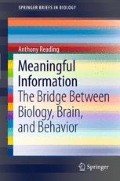Abstract
Living cells and organisms can not only detect meaningful information but can also communicate it to other cells and organisms. Communication is a process in which one entity generates or displays a pattern of matter or energy that is detected by another and results in a change in the latter’s behavior, functioning, or structure, without a direct exchange of energy between them. Cues, signals, and messages are the different forms of meaningful information that can be exchanged between biological senders and receivers. The cells of multicellular organisms communicate with one another to coordinate their activities and regulate their functioning. Social animals use their long-distance senses of vision, hearing, and olfaction to transmit information to others and receive it from them. Although energy is required to transmit and respond to information, neither the nature of the information being transmitted nor the response it generates is related to the energy involved.
Access this chapter
Tax calculation will be finalised at checkout
Purchases are for personal use only
Notes
- 1.
Notes
The field of Biosemiotics developed by Thomas Sebeok (1920–2001) involves the study of communicative signs in living systems. Semiotics, the discipline from which it is derived, is concerned primarily with understanding signification, rather than information. It regards all information as signs, which are conceptualized along lines pioneered by C. S. Peirce (1839–1914) as things that stand for something else, to someone, in some capacity. Biosemiotics applies concepts developed initially for understanding human communication to a range of biological phenomena, including genetic and cellular processes. However, because of its different orientation, the way it deals with these topics differs from the one proposed here. Information about Biosemiotics can be found in Sebeok and Umiker-Sebeok (1992), Petrilli and Ponzio (2001), Barbieri (2003), and Barbieri (2006).
- 2.
The idea that signals and messages are different from cues because they (signals and messages) are intentionally generated is difficult to apply to entities that do not have conscious intentions. The approach taken here is that signals in organisms that lack conscious choice have been shaped by natural selection and are generated automatically. The meaning of cues, like storm clouds in the sky or brown patches in a lawn, is generally learned from the effects they produce.
- 3.
Hieroglyphics, notched sticks, and cave art were probably the first relatively lasting ways of transmitting information to recipients who were not physically present. The first commercial system for sending information over distances was the electric telegraph that Samuel Morse and Alfred Vail patented in 1837. Its messages were transmitted in “Morse Code,” a system that represents the alphabet by dots and dashes that are conveyed by electric currents of either short or long duration. The first long-distance voice transmission was sent over a copper wire between Washington and Baltimore in 1844, which was followed by Alexander Graham Bell’s introduction of the telephone in 1876. Wireless forms of transmission were then developed by Guglielmo Marconi in the late 1890s (Pierce 1980).
References
Alcock J (2005) Animal Behavior: An Evolutionary Approach, 8th edn. Sinauer Associates, Sunderland
Barbieri M (2003) The Organic Codes: an Introduction to Semantic Biology. Cambridge University Press, Cambridge
Barbieri M (2006) Introduction to Biosemiotics: The New Biological Synthesis. Springer, Dordrecht
Cheney DL, Seyfarth RM (1990) How Monkeys See the World. University of Chicago Press, Chicago
Crick F (1970) Central dogma of molecular biology. Nature 227: 561–563
Deacon TW (1997) The Symbolic Species: The Co-Evolution of Language and the Brain. WW Norton, New York
Darwin C (1872, 1934) The Expression of the Emotions in Man and Animals. Abridged edn. Watts, London
Evans WF (1968) Communication in the Animal World. Crowell, New York
Judson O (2002) Dr. Tatiana’s Sex Advice to All Creation: The Definitive Guide to the Evolutionary Biology of Sex. Metropolitan Books, New York
Lewis BD, Gower DM (1980) Biology of Communication. John Wiley & Sons, New York
Maynard-Smith J, Harper D (2003) Animal Signals. Oxford University Press, Oxford
Petrilli S, Ponzio A (2001) Thomas Sebeok and the Signs of Life. Icon Books, Cambridge
Pierce JR (1980) An Introduction to Information Theory: Symbols, Signals and Noise, 2nd edn. Dover Publications, New York
Sebeok TA, Umiker-Sebeok J (1992) Biosemiotics. The Semiotic Web. Mouton de Gruyter, New York
Tinbergen N (1953) Social Behavior in Animals: With Special Reference to Vertebrates. John Wiley & Sons, New York
Author information
Authors and Affiliations
Corresponding author
Rights and permissions
Copyright information
© 2011 Springer Science+Business Media, LLC
About this chapter
Cite this chapter
Reading, A. (2011). Communication. In: Meaningful Information. SpringerBriefs in Biology, vol 1. Springer, New York, NY. https://doi.org/10.1007/978-1-4614-0158-2_10
Download citation
DOI: https://doi.org/10.1007/978-1-4614-0158-2_10
Published:
Publisher Name: Springer, New York, NY
Print ISBN: 978-1-4614-0157-5
Online ISBN: 978-1-4614-0158-2
eBook Packages: Biomedical and Life SciencesBiomedical and Life Sciences (R0)

